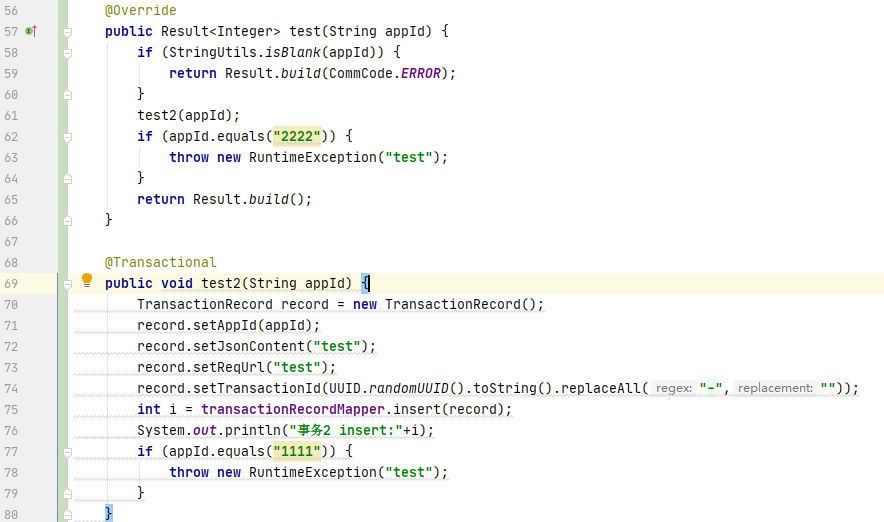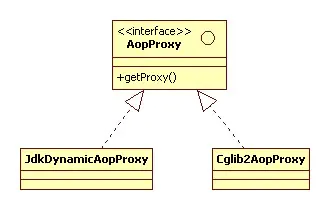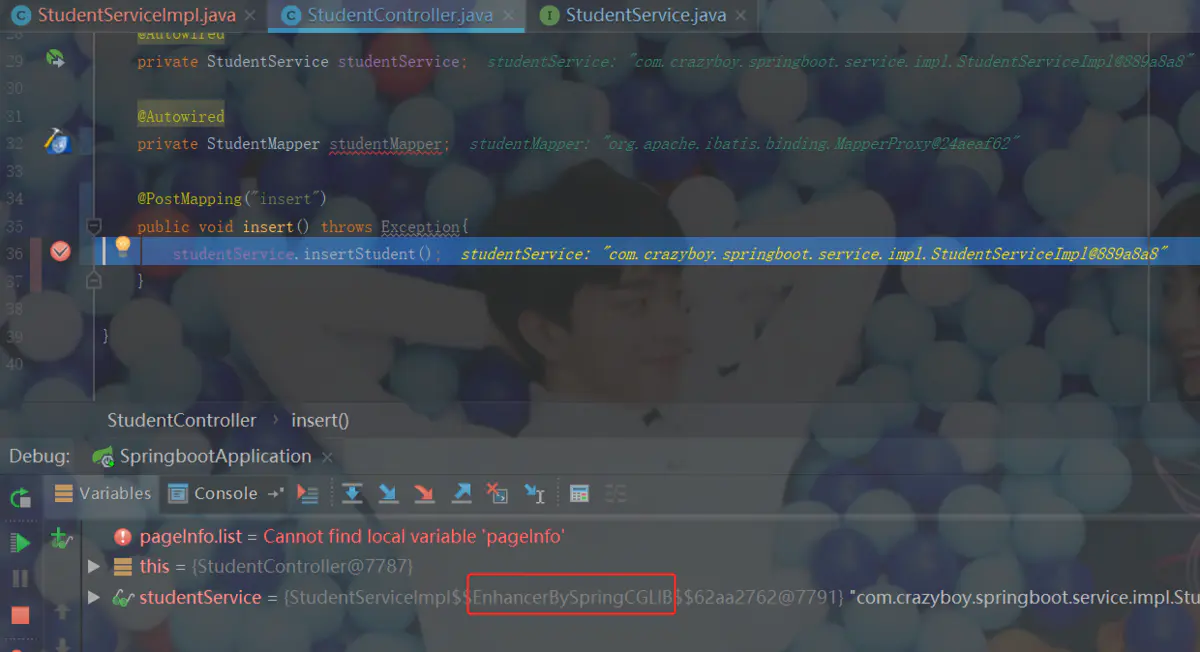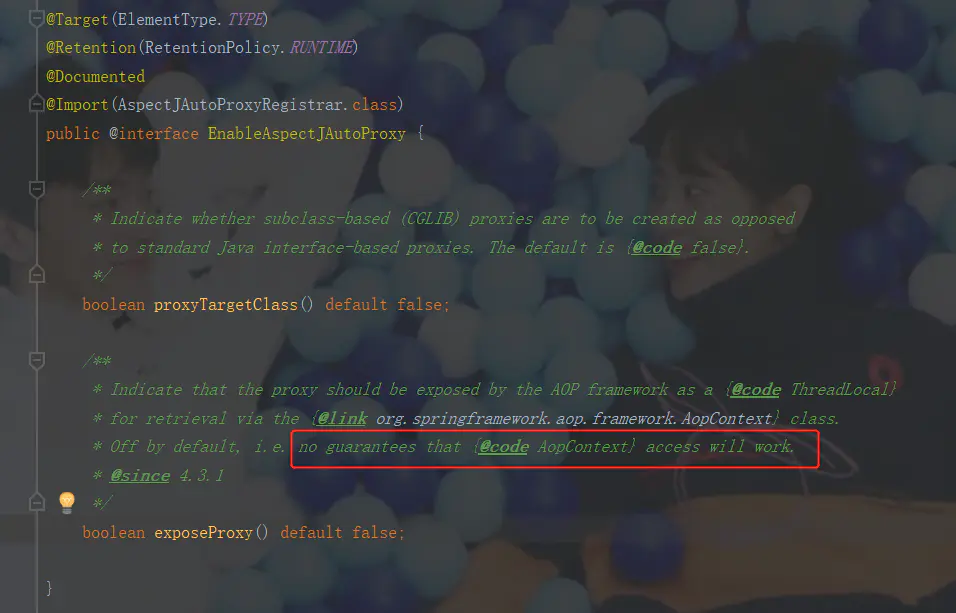
简称: test=a,test2=b
此时,调用a方法,b里的事务将不生效
这个问题,表面上是事务声明失效的问题,实质上很可能是Spring的AOP机制实现角度的问题。我想到很久以前研究Spring的AOP实现时发现的一个现象:对于以Cglib方式增强的AOP目标类,会创建两个对象,一个事Bean实例本身,一个是Cglib增强代理对象,而不仅仅是只有后者。我曾经疑惑过这一点,但当时没有再仔细探究下去。
我们知道,Spring的AOP实现方式有两种:1、Java代理方式;2、Cglib动态增强方式,这两种方式在Spring中是可以无缝自由切换的。Java代理方式的优点是不依赖第三方jar包,缺点是不能代理类,只能代理接口。
Spring通过AopProxy接口,抽象了这两种实现,实现了一致的AOP方式:


因此,从上面的分析可以看出,methodB没有被AopProxy通知到,导致最终结果是:被Spring的AOP增强的类,在同一个类的内部方法调用时,其被调用方法上的增强通知将不起作用。
而这种结果,会造成什么影响呢:
1:内部调用时,被调用方法的事务声明将不起作用
2:换句话说,你在某个方法上声明它需要事务的时候,如果这个类还有其他开发者,你将不能保证这个方法真的会在事务环境中
3:再换句话说,Spring的事务传播策略在内部方法调用时将不起作用。不管你希望某个方法需要单独事务,是RequiresNew,还是要嵌套事务,要Nested,等等,统统不起作用。
4:不仅仅是事务通知,所有你自己利用Spring实现的AOP通知,都会受到同样限制。。。。
解决办法:
spring同类调用事务不生效-原因及三种解决方式
spring提供的声明式事务注解@Transactional,极大的方便了开发者管理事务,无需手动编写开启、提交、回滚事务的代码。
但是也带来了一些隐患,如果注解使用不当,可能导致事务不生效,最终导致脏数据也入库。
如果在同一个类直接调用事务方法,就会导致事务不生效,示例如下
public class StudentServiceImpl implements StudentService {
@Autowired
private StudentMapper studentMapper;
@Override
public void insertStudent(){
insert();
}
@Transactional(rollbackFor = Exception.class)
public void insert() {
StudentDO studentDO = new StudentDO();
studentDO.setName("小民");
studentDO.setAge(22);
studentMapper.insert(studentDO);
if (studentDO.getAge() > 18) {
throw new RuntimeException("年龄不能大于18岁");
}
}
}
事务不生效的原因在于,spring基于AOP机制实现事务的管理,@Authwired StudentService studentService这样的方式,调用StudentService的方法时,实际上是通过StudentService的代理类调用StudentService的方法,代理类在执行目标方法前后,加上了事务管理的代码。

因此,只有通过注入的StudentService调用事务方法,才会走代理类,才会执行事务管理;如果在同类直接调用,没走代理类,事务就无效。
注意:除了@Transactional,@Async同样需要代理类调用,异步才会生效
但是在实际的业务场景中,同类调用事务方法难以避免,怎么让同类调用时事务依然生效呢?有以下三个方法
方法一
自己@Autowired自己,示例如下
@Service
public class StudentServiceImpl implements StudentService {
@Autowired
private StudentMapper studentMapper;
@Autowired
private StudentService studentService;
@Override
public void insertStudent(){
studentService.insert();
}
@Override
@Transactional(rollbackFor = Exception.class)
public void insert() {
StudentDO studentDO = new StudentDO();
studentDO.setName("小民");
studentDO.setAge(22);
studentMapper.insert(studentDO);
if (studentDO.getAge() > 18) {
throw new RuntimeException("年龄不能大于18岁");
}
}
}
可能有人会担心这样会有循环依赖的问题,事实上,spring通过三级缓存解决了循环依赖的问题,所以上面的写法不会有循环依赖问题。
但是!!!,这不代表spring永远没有循环依赖的问题(@Async导致循环依赖了解下)
方法二
使用AopContext获取到当前代理类,需要在启动类加上@EnableAspectJAutoProxy(exposeProxy = true),
示例如下
@Service
public class StudentServiceImpl implements StudentService {
@Autowired
private StudentMapper studentMapper;
@Override
public void insertStudent(){
getService().insert();
}
@Override
@Transactional(rollbackFor = Exception.class)
public void insert() {
StudentDO studentDO = new StudentDO();
studentDO.setName("小民");
studentDO.setAge(22);
studentMapper.insert(studentDO);
if (studentDO.getAge() > 18) {
throw new RuntimeException("年龄不能大于18岁");
}
}
/**
* 通过AopContext获取代理类
* @return StudentService代理类
*/
private StudentService getService(){
return Objects.nonNull(AopContext.currentProxy()) ? (StudentService)AopContext.currentProxy() : this;
}
}
exposeProxy = true用于控制AOP框架公开代理,公开后才可以通过AopContext获取到当前代理类。(默认情况下不会公开代理,因为会降低性能)
注意:不能保证这种方式一定有效,使用@Async时,本方式可能失效。
(从@Async案例找到Spring框架的bug:exposeProxy=true不生效原因大剖析)

方式三(推荐)
通过spring上下文获取到当前代理类,示例如下
@Component
public class SpringBeanUtil implements ApplicationContextAware {
private static ApplicationContext applicationContext;
@Override
public void setApplicationContext(ApplicationContext applicationContext) throws BeansException {
this.applicationContext = applicationContext;
}
/**
* 通过class获取Bean
* @param clazz class
* @param <T> 泛型
* @return bean
*/
public static <T> T getBean(Class<T> clazz) {
return applicationContext.getBean(clazz);
}
}
@Service
public class StudentServiceImpl implements StudentService {
@Autowired
private StudentMapper studentMapper;
@Override
public void insertStudent(){
StudentService bean = SpringBeanUtil.getBean(StudentService.class);
if (null != bean) {
bean.insert();
}
}
@Override
@Transactional(rollbackFor = Exception.class)
public void insert() {
StudentDO studentDO = new StudentDO();
studentDO.setName("小民");
studentDO.setAge(22);
studentMapper.insert(studentDO);
if (studentDO.getAge() > 18) {
throw new RuntimeException("年龄不能大于18岁");
}
}
}
当一个类实现ApplicationContextAware接口后,就可以方便的获得ApplicationContext中的所有bean。
原文出处:https://www.jianshu.com/p/083605986c8f
来源:简书